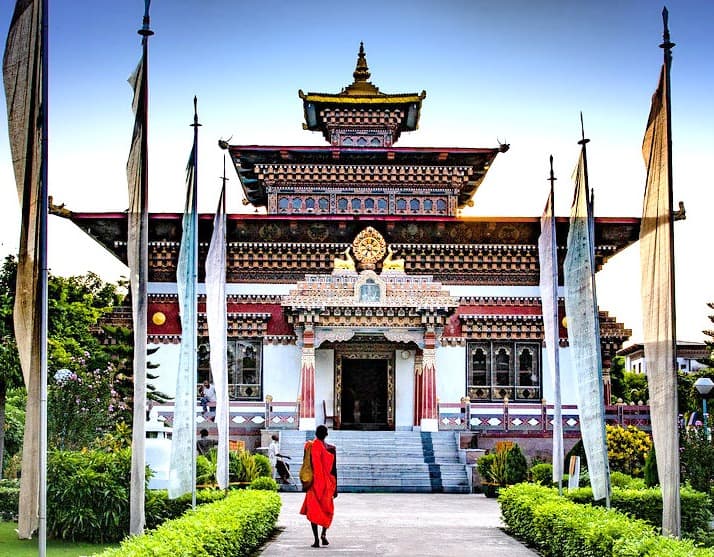Discover the spiritual heart of the Tibetan plateau by exploring its revered monasteries, each a beacon of religious significance and architectural magnificence. This Tibet monastery tour guide showcases the best monasteries in Tibet, from the iconic Potala Palace with its deep historical roots to the vibrant debate sessions at Sera Monastery. Journey through the sacred corridors of Jokhang Temple, a key Tibetan Buddhism sacred site, and immerse yourself in the profound teachings and tranquil surroundings of Drepung Monastery. Whether you're seeking a deeper understanding of Tibetan religious sites or the serene beauty of ancient monasteries, our guide highlights must-visit Tibetan monasteries for an enriching spiritual experience. Join us to explore these top Buddhist monasteries in Tibet, where spirituality meets cultural heritage, making each visit a profound pilgrimage.
At Druk Holidays, we pride ourselves on offering the premier travel experiences to the sacred monasteries of Tibet. Our expertly curated Tibet monastery tours are designed to guide you through the most spiritual journey destinations in the region. From the majestic Potala Palace to the historic depths of Jokhang Temple and the scholarly environs of Drepung Monastery, we ensure that each visit provides a profound understanding and appreciation of Tibetan Buddhism sacred sites. Whether you're a spiritual seeker or a lover of rich cultural heritage, Druk Holidays is your trusted companion for uncovering the best monasteries in Tibet, offering both tours and transformative experiences. Join us to explore these famous Tibetan monasteries and immerse yourself in Tibet's unparalleled spiritual and cultural landscapes.
Potala Palace
The Potala Palace, standing majestically in the heart of Lhasa, is not just a palace but a monumental symbol of Tibetan spiritual and political history. Originally constructed in the 7th century by King Songtsen Gampo and later rebuilt in the 17th century by the 5th Dalai Lama, this iconic structure has served as the winter residence of the Dalai Lamas. It is an architectural marvel that combines the grandeur of a palace with the solemnity of a monastery, making it a must-visit for anyone traveling to Tibet.
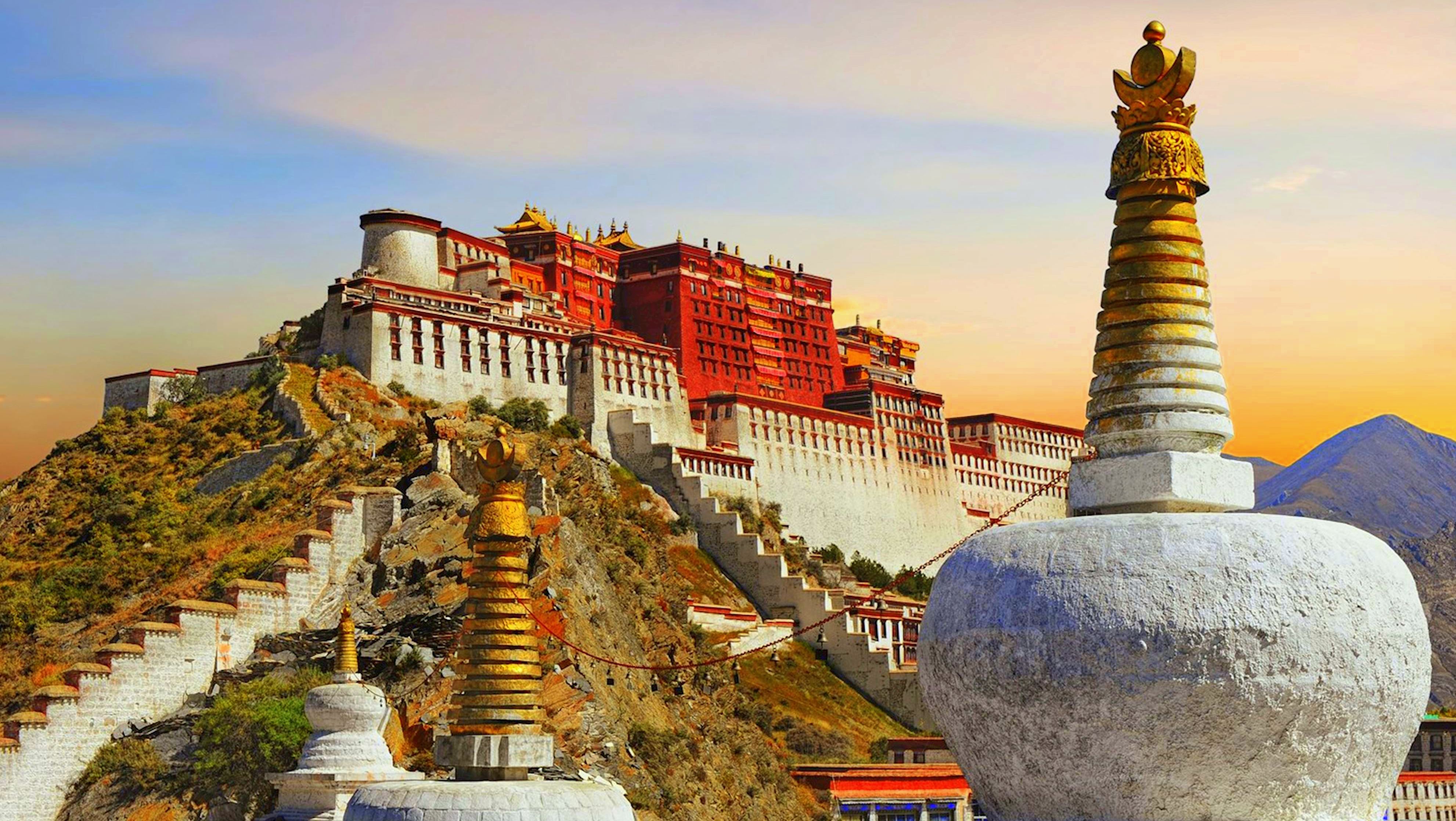
- Architectural Grandeur: The palace is an outstanding example of Tibetan architecture, featuring intricate designs and a robust structure that stands atop Marpo Ri hill, overlooking the city of Lhasa.
- Spiritual Significance: As the former residence of successive Dalai Lamas, Potala Palace holds immense spiritual importance in Tibetan Buddhism.
- Cultural Treasures: The palace houses a vast collection of artworks, murals, thangkas, and statues, each telling a story of Tibet’s religious and cultural history.
- Historical Artifacts: Visitors can view a range of Tibetan relics, including sacred scriptures and personal items of previous Dalai Lamas.
- Chapels and Temples: Numerous chapels and temples within the palace, including the revered Dharma Cave and the Saint’s Chapel, are crucial for Buddhist worship and pilgrimage.
- Panoramic Views: From its lofty position, the palace offers breathtaking views of Lhasa and the surrounding mountains, a perfect backdrop for contemplation and photography.
- World Heritage Site: Recognized as a UNESCO World Heritage Site, Potala Palace is acknowledged globally for its historical and cultural significance.
- Cultural Events: The palace is the center of many Tibetan festivals and rituals, providing visitors with a deeper insight into the vibrant local traditions.
Potala Palace is not just a destination but a profound experience, encapsulating the essence of Tibetan Buddhism and its rich history. It stands as a beacon of Tibetan resilience and spiritual devotion, offering insight into the complex interplay between religion and governance in Tibet. Visiting the Potala Palace provides not only a visual feast but also a deeper understanding of Tibetan culture and history, making it an essential stop for anyone seeking to explore the depth of Tibet’s heritage.
Jokhang Temple
Jokhang Temple, located in the heart of Lhasa, is the most sacred and revered religious site in Tibet. Founded in the 7th century by King Songtsen Gampo to accommodate the statues of Buddha brought as dowries by his foreign wives, it has since grown to be the focal point of Tibetan Buddhist pilgrimages. The temple uniquely showcases architectural elements from India, Nepal, and Tibet, symbolizing the amalgamation of different Buddhist cultural influences.
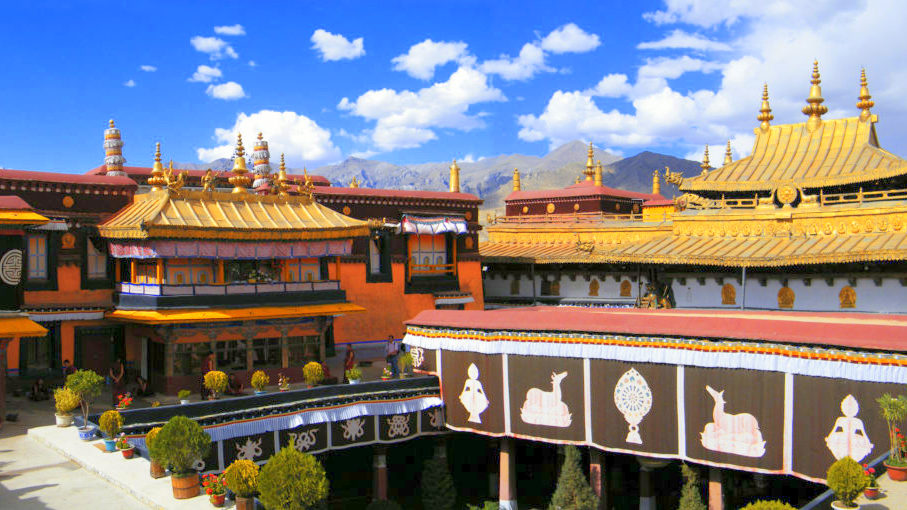
- Architectural Fusion: The temple’s design reflects a blend of Indian vihara design, Tibetan and Nepalese architectural elements, creating a distinctive and harmonious aesthetic.
- Spiritual Hub: It serves as the ultimate pilgrimage destination for Tibetan Buddhists, who travel from all parts of Tibet to perform prostration rituals in its forecourt.
- Statue of Jowo Rinpoche: The temple houses the venerated Jowo Rinpoche, a life-sized (5 foot) statue of the 12-year-old Buddha Shakyamuni, considered the most sacred object in Tibet.
- Rooftop Views: The temple’s accessible rooftop offers panoramic views of bustling Barkhor Street, providing a picturesque vista of the pilgrims and the surrounding cityscape.
- Murals and Artworks: Inside, the temple walls are adorned with intricate murals and artworks that depict various aspects of Tibetan Buddhism and its deities, educating devotees and tourists alike.
- Cultural Significance: The Jokhang is not just a spiritual center but also a testament to the resilience and persistence of Tibetan culture under various political pressures.
- Festivals and Rituals: It is the epicenter of numerous Buddhist festivals, including the Great Prayer Festival (Monlam Chenmo), which attracts thousands of monks, nuns, and laypeople for prayers and celebrations.
- UNESCO World Heritage Site: The Jokhang Temple, along with other sites in Lhasa, has been designated as part of the Historic Ensemble of the Potala Palace UNESCO World Heritage site, underscoring its global cultural importance.
The Jokhang Temple stands not only as a monument of great beauty and profound spirituality but also as the heart of Tibetan Buddhism, playing a crucial role in the religious life of Tibetans. Visiting the Jokhang offers an unparalleled insight into the deep devotion and religious practices that define Tibet, making it an essential experience for anyone seeking to understand the spiritual and cultural depth of this extraordinary region.
Sera Monastery
Sera Monastery is one of the great monastic universities of Tibet, established in 1419 by Jamchen Chojey, a disciple of Tsongkhapa, the founder of the Gelugpa sect. Nestled just a few miles north of Lhasa, Sera is renowned for its distinctive approach to Buddhist philosophy and education, especially through its lively debate sessions, which are a spectacle in themselves. This monastery remains an active scholarly institution and a key destination for visitors interested in the dynamics of monastic education and religious practices.
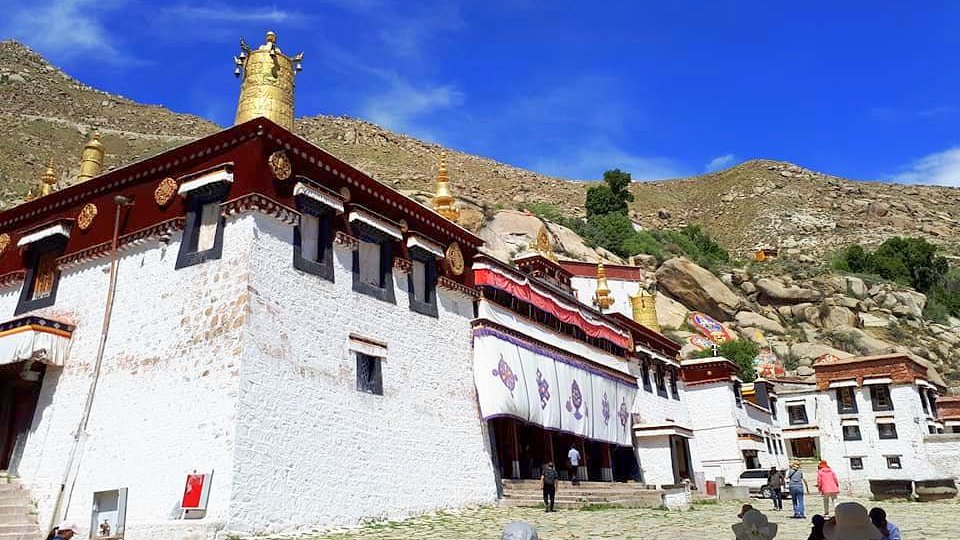
- Debate Sessions: The highlight of a visit to Sera Monastery is witnessing the monks' debate on Buddhist doctrines, a critical method of learning and honing their understanding. These debates are vibrant and animated, characterized by physical gestures that help sharpen concentration and analytical skills.
- Monastic Education: Sera is one of the three great universities of Tibet, along with Ganden and Drepung, focusing extensively on the study of Buddhism, philosophy, and various other religious texts.
- Architectural Beauty: The monastery complex features beautiful architecture, including assembly halls, chapels, and monk quarters, all set against the backdrop of beautiful mountains.
- Historical Artworks: The halls of Sera Monastery are adorned with intricate murals, thangkas, and statues that chronicle the life of Buddha and the history of the monastery.
- Community Engagement: The monastery serves as a community hub where hundreds of monks live and study, providing visitors with a glimpse into the monastic lifestyle.
- Cultural Preservation: Sera Monastery is instrumental in preserving Tibetan culture, religious practices, and language, especially in light of the challenges posed by the modern geopolitical landscape.
- Scenic Surroundings: Located on the outskirts of Lhasa, the monastery is surrounded by serene wilderness, offering peaceful vistas and a tranquil environment for contemplation and study.
- Accessibility and Visitor Facilities: The monastery is equipped to handle tourists, with guided tours that help explain the historical and cultural significance of various sites within the complex.
Sera Monastery stands as a bastion of Tibetan education and religious practice. Its unique combination of scholastic endeavor, religious fervor, and cultural preservation makes it an invaluable site for both pilgrims and tourists. Visiting Sera not only provides insight into the intellectual rigors of monastic life but also offers a deeper understanding of the spiritual and cultural fabric of Tibet. Whether you're drawn by the intellectual challenge of the debates or the serene beauty of its setting, Sera Monastery offers a profound glimpse into the heart of Tibetan Buddhism.
Drepung Monastery
Drepung Monastery, once the world's largest monastery, is a cornerstone of Tibetan Buddhism. Established in 1416 on the outskirts of Lhasa by Jamyang Choge Tashi Palden, one of Tsongkhapa's main disciples, it has historically housed up to 10,000 monks. This monastery is renowned for its role in the education of monks and its significant religious and cultural impact on Tibet.
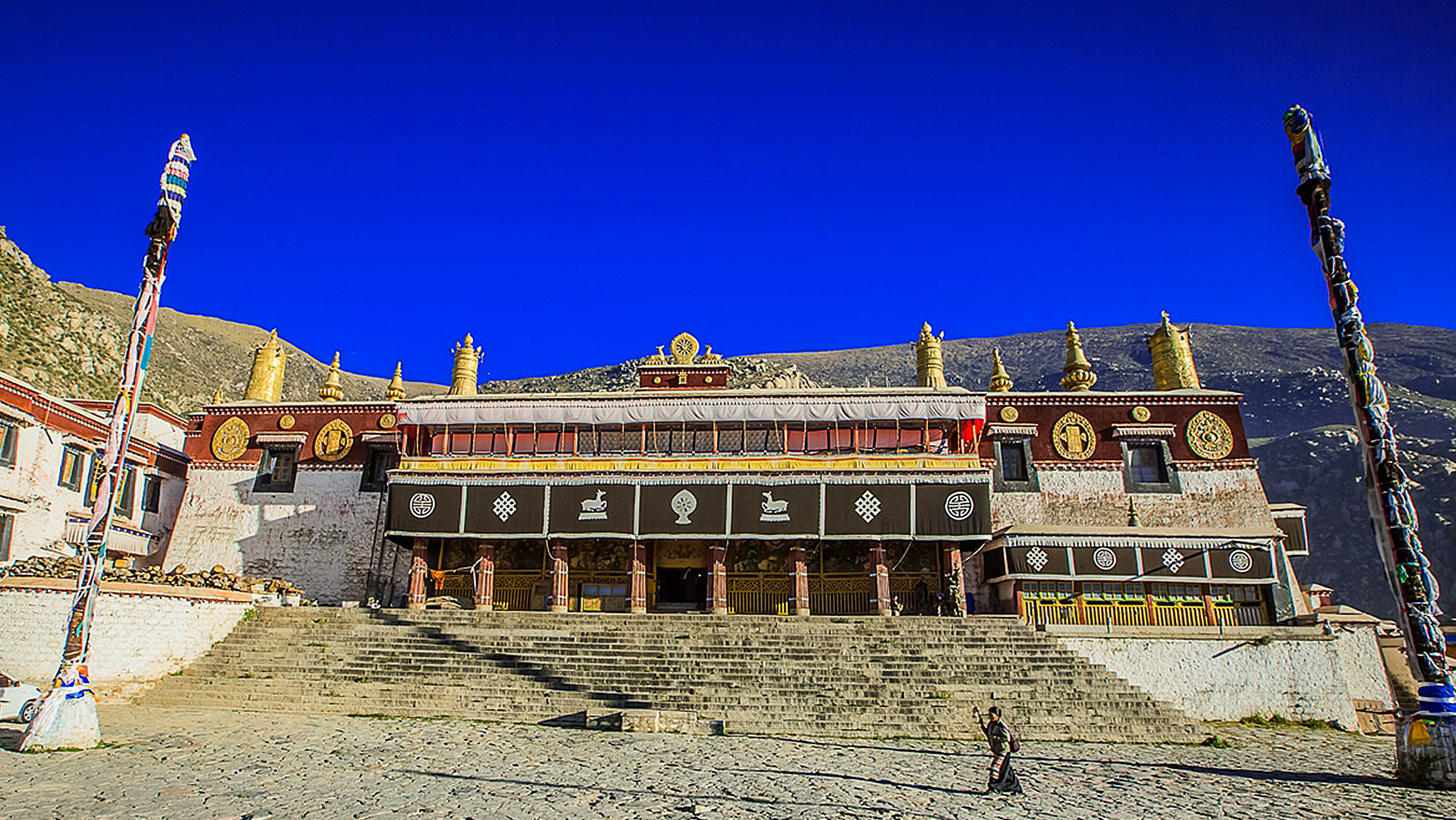
- Scale and Structure: As one of the largest monastic sites, Drepung Monastery sprawls over the Gambo Utse mountain, resembling a heap of rice from afar, which is what 'Drepung' literally translates to.
- Rich Educational Heritage: Known as a premier place of learning, Drepung has numerous khangtsens (monastic colleges) that specialize in different branches of Buddhist study, reflecting its status as a major scholastic center.
- Great Assembly Hall: The heart of the monastery, the Great Assembly Hall, is an architectural marvel and the primary venue for religious ceremonies and monk gatherings.
- Historic Chapels and Art: The monastery is home to many chapels that house exquisite statues, thangkas, and murals, including those dedicated to Dalai Lamas who once resided here.
- Annual Shoton Festival: Drepung is famous for hosting the Shoton Festival, highlighted by the unveiling of a giant thangka of the Buddha, attracting thousands of pilgrims and visitors.
- Spiritual Practices: Beyond its educational activities, Drepung is a vibrant center of meditation and religious practice, with monks engaging in various rituals and spiritual disciplines.
- Ganden Palace: Originally the residence of the second Dalai Lama, this area within Drepung adds historical depth and spiritual significance to the monastery.
- Tourist Accessibility: Drepung is accessible to visitors, offering guided tours that explain the monastery’s history, architecture, and religious functions, making it a vital stop for those interested in the richness of Tibetan culture.
Drepung Monastery remains a profound symbol of Tibetan spiritual and academic life. Visiting Drepung offers a unique window into the practices and teachings that have shaped Tibetan Buddhism over the centuries. Its blend of religious fervor, scholarly pursuit, and cultural richness makes it one of the must-visit Tibetan monasteries, offering insights and inspiration to all who walk its sacred grounds.
Tashilhunpo Monastery
Tashilhunpo Monastery stands as a historic and spiritual beacon in Shigatse, the second-largest city in Tibet. Founded in 1447 by Gendun Drup, the First Dalai Lama, it is renowned as the seat of the Panchen Lama, the second most important spiritual leader in Tibetan Buddhism after the Dalai Lama. This monastery is not only a center for religious study and practice but also a repository of immense cultural and artistic heritage.
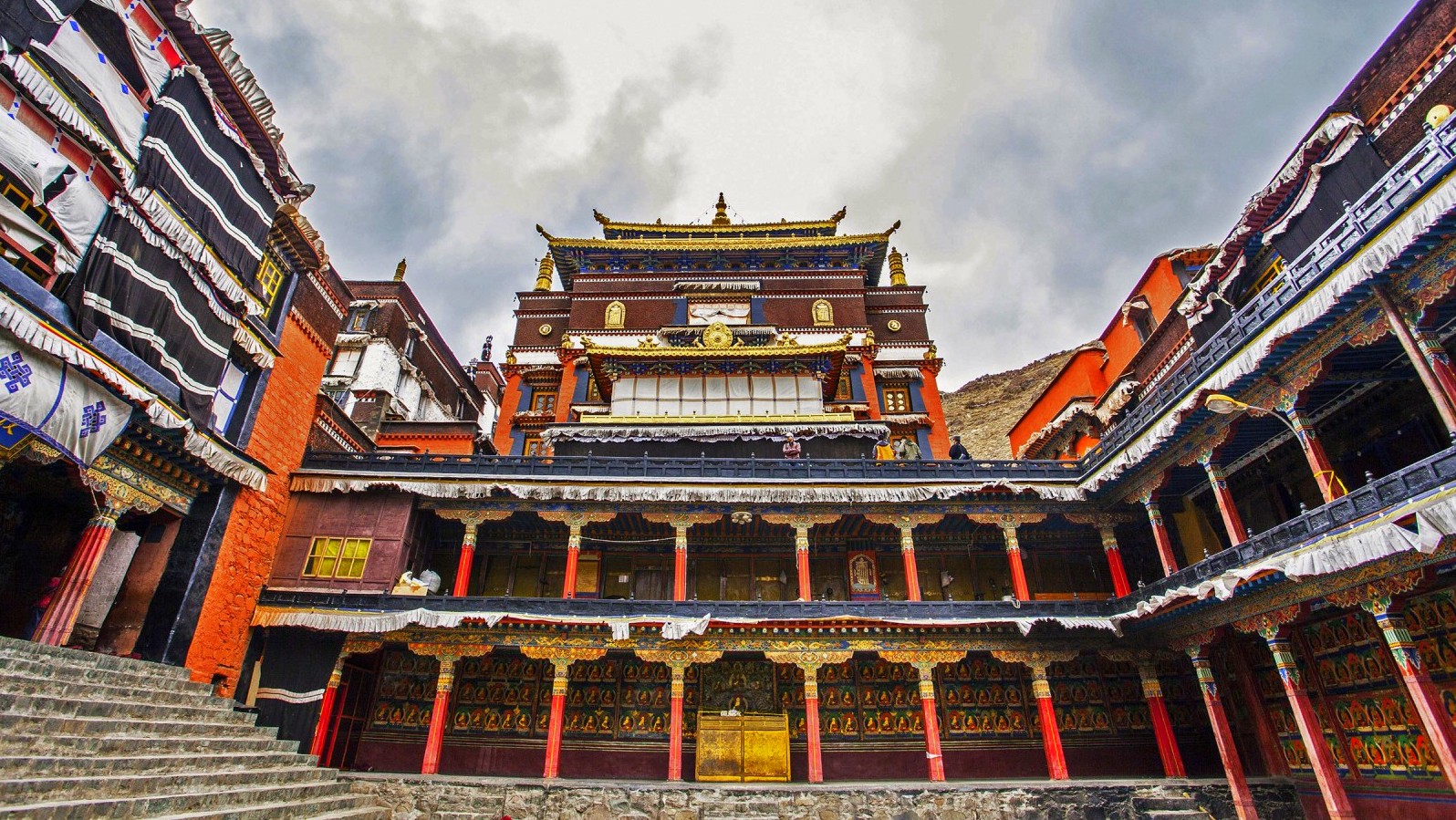
- Seat of the Panchen Lama: Tashilhunpo is vital in Tibetan Buddhism as the traditional residence of the Panchen Lama, making it a critical site for religious and historical pilgrimages.
- Maitreya Buddha Statue: The monastery is famous for its enormous statue of the Maitreya Buddha (Future Buddha), which stands at over 86 feet tall and is one of the largest gilded statues in the world.
- Architectural Grandeur: With its expansive and well-preserved complex of buildings, Tashilhunpo showcases superb examples of Tibetan religious architecture, including large halls, intricate chapels, and vibrant murals.
- Vast Library of Texts: Housing thousands of texts on Buddhist philosophy, medicine, and astrology, the monastery’s library is an invaluable resource for scholars of Tibetan culture.
- Cultural Festivals: Tashilhunpo is the site of the annual Thangka Unveiling, part of the Buddha Maitreya Festival, which attracts thousands of pilgrims and visitors keen to witness this spectacular religious event.
- Panoramic Views: Located on a hill in the center of Shigatse, the monastery offers panoramic views of the surrounding city and valleys, adding a picturesque quality to its spiritual and cultural allure.
- Artistic Heritage: The monastery is adorned with a vast collection of artistic treasures, including statues, thangkas, and murals that depict various aspects of Buddhist theology and mythology.
- Spiritual and Educational Center: As a major monastic education center, Tashilhunpo continues to train hundreds of monks, maintaining its long-standing tradition of religious scholarship and practice.
Tashilhunpo Monastery is not just a monument of religious importance but also a living community where the traditions of Tibetan Buddhism are actively preserved and practiced. Its profound spiritual significance and rich cultural heritage make it a cornerstone of Tibetan Buddhism and a must-visit for anyone interested in understanding the depth and breadth of this ancient religious tradition. Whether you are drawn by its historical significance, architectural beauty, or spiritual depth, Tashilhunpo offers a truly enriching experience.
Ganden Monastery
Ganden Monastery stands prominently as one of the "great three" Gelug university monasteries of Tibet, located atop Wangbur Mountain at an altitude of 4,300 meters. Founded in 1409 by Je Tsongkhapa, the founder of the Gelugpa school of Tibetan Buddhism, Ganden is not only a site of deep religious importance but also a place of natural beauty and panoramic views.
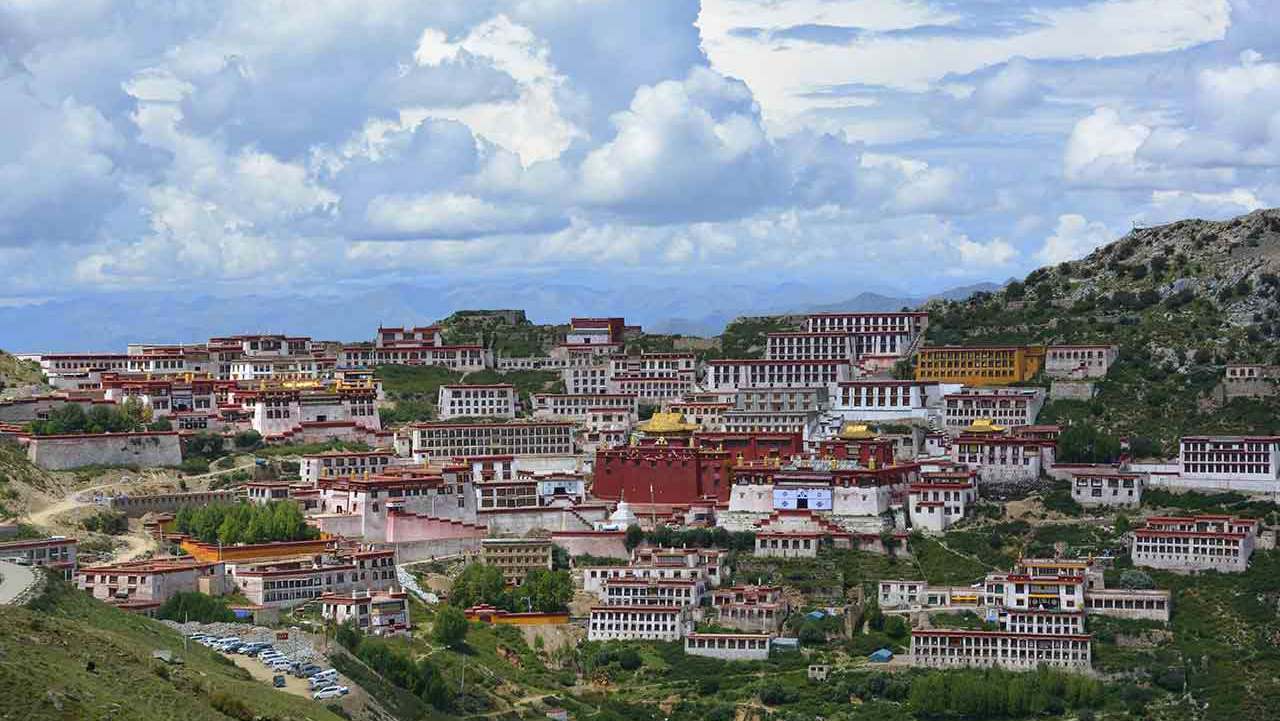
- Historical Significance: As the first monastery of the Gelug order, Ganden holds a special place in Tibetan Buddhism, embodying the visions and teachings of Tsongkhapa.
- Architectural Features: The monastery's layout includes a series of artistic assembly halls, chapels, and monk residences, structured around courtyards that follow the contour lines of the mountaintop.
- Tsokchen Assembly Hall: The main assembly hall, Tsokchen, is a focal point of the monastery, where monks gather for prayers and ceremonies. It houses magnificent statues and murals depicting various aspects of Buddhist lore.
- Scenic Trekking Routes: Surrounding Ganden are numerous trekking routes that offer spectacular views of the Lhasa River Valley and the snow-capped peaks of the Himalayas, making it a favorite destination for both pilgrims and trekkers.
- Spiritual Practices: Ganden is renowned for its scholarly environment and rigorous practices in Buddhist philosophy, logic, and metaphysics, continuing its tradition as a major educational and religious center.
- Annual Ganden Thangka Festival: This festival sees the unfurling of a giant thangka painting on the monastery walls, a significant religious event attended by thousands of devotees.
- 360-Degree Views: The monastery’s location offers unmatched 360-degree views of the surrounding landscapes, providing a serene and contemplative environment.
- Relics and Sacred Sites: Among its sacred sites, Ganden houses the tomb of Tsongkhapa, containing relics of his body, making it a profoundly sacred place for followers of the Gelugpa tradition.
Ganden Monastery is a jewel in the crown of Tibetan spiritual sites, offering a unique blend of religious significance, academic heritage, and natural beauty. Its historical and cultural depth provides a comprehensive insight into Gelugpa Buddhism, while the natural surroundings offer peaceful respite and breathtaking views. Whether you are seeking spiritual insight, historical knowledge, or simply the tranquility of sacred spaces, Ganden Monastery is an indispensable part of any visit to Tibet.
Best Time to Visit the Top Monasteries in Tibet
Visiting the top monasteries in Tibet is not just a journey into the spiritual heart of Tibetan Buddhism, but also an encounter with some of the most dramatic landscapes on earth. To fully appreciate these sacred sites, timing your visit correctly is crucial, as Tibet's unique climate and high altitude can significantly impact travel plans.
- Spring (April to Early June): Spring is one of the best times to visit Tibet's monasteries. The weather begins to warm up, and the landscape transforms with blooming flowers and lush greenery, creating a vibrant backdrop for your monastery visits. This season offers clear, blue skies and relatively mild weather, making it ideal for exploring outdoor sites and engaging with the local festivals that occur during this time.
- Summer (Late June to August): Summer is the peak tourist season in Tibet due to its warm weather and the influx of Chinese tourists during their summer holidays. While this season offers warmer temperatures and more comfortable travel conditions, it also brings occasional rain showers. The rain usually doesn't last long and often clears up, providing fresh air and clear skies. Visiting during this time also allows you to witness the Shoton Festival, one of Tibet's most important religious celebrations, featuring Buddha painting exhibitions and various cultural performances.
- Autumn (September to October): Autumn is considered the best overall time for visiting Tibet, including its monasteries. The weather is stable with clear, crisp air and uninterrupted views of the Himalayas. This is also the time when the landscapes turn golden and the harvests take place, offering picturesque scenes perfect for photography. Monasteries such as Ganden, Sera, and Drepung are particularly stunning against the backdrop of autumn colors.
- Winter (November to March): Winter in Tibet is cold, but it's also the season with the fewest tourists, offering a more solitary and introspective experience at its monasteries. The major monastic festivals like Monlam Chenmo (Great Prayer Festival) occur during this time, particularly in Lhasa, giving visitors a profound insight into the spiritual practices and traditions of Tibetan Buddhism.
Each season offers a unique perspective and experience of Tibet's top monasteries. Whether you're looking for vibrant festival experiences or quiet, contemplative moments amidst ancient architecture and stunning landscapes, choosing the right time to visit can greatly enhance your spiritual and cultural journey in Tibet.
Essential Tips for Visiting the Top Monasteries in Tibet
Visiting the ancient monasteries of Tibet is an enriching experience that offers insights into the deep spiritual traditions and unique cultural heritage of the region. However, due to its unique geographical and cultural conditions, it's important to prepare well. Here are essential tips to help ensure a respectful, enjoyable, and safe visit to the top monasteries in Tibet.
Respect Religious Customs and Traditions
- Dress Modestly: Wear respectful clothing that covers shoulders and knees. Monasteries are sacred places, and dressing appropriately shows respect for the local culture and religious practices.
- Follow Local Customs: In Tibetan Buddhist sites, it is customary to walk around stupas, temples, and prayer wheels in a clockwise direction. Always follow this rule to show respect.
Acclimatize to High Altitudes
- Take Your Time: Most of Tibet is at a high altitude, with Lhasa itself around 3,500 meters above sea level. Allow several days to acclimatize before engaging in strenuous activity like climbing lots of steps in monasteries.
- Stay Hydrated and Monitor Health: Drink plenty of water, eat light meals and keep an eye on your body's reaction to the altitude.
Understand Photography Etiquette
- Ask Permission: Always check if photography is allowed inside the monasteries. Some areas may permit photos without a fee, others may charge a small fee, or photography might be completely forbidden.
- Be Discreet: When photography is allowed, use your camera discreetly and avoid using flash as it can damage ancient artifacts and disturb others.
Plan Visits According to the Liturgical Calendar
- Check for Special Events: Visiting during religious festivals can be a spectacular experience, offering deeper insight into Tibetan Buddhism and its practices. However, remember that these are also sacred times, so additional respect and sensitivity are required.
Engage with the Community
- Participate in Teachings and Prayers: If possible, participate in public teachings or prayer sessions. It’s a profound way to connect with the spiritual life of the monastery.
- Support Local Economy: Purchase crafts or food from local vendors around the monasteries. This helps support the local community economically.
Secure Necessary Permits
- Travel Permits: Besides a Chinese visa, you’ll need specific permits to visit Tibet. Coordinate with a travel agency well in advance to ensure all paperwork is in order.
Guide and Interpreter
- Hire a Local Guide: A knowledgeable local guide can enhance your visit by providing background information on the history and significance of the sites. They can also assist with language barriers.
Leave No Trace
- Respect the Environment: Keep the monastery grounds clean by carrying out any trash and avoiding disposable plastics. This respect for the environment aligns with the Buddhist principle of compassion towards all living beings.
Visiting Tibet's monasteries is more than just a tourist experience; it's a chance to immerse yourself in a deeply spiritual culture. By following these tips, you not only ensure a more meaningful visit but also contribute positively to the preservation of Tibet's sacred sites and the well-being of its communities.
Exploring the top monasteries in Tibet offers a unique and profound insight into the spiritual depth and cultural heritage of the region. Each monastery, from the iconic Potala Palace to the serene Ganden Monastery, presents a different facet of Tibetan Buddhism, enriched by centuries of history and devotion. These sacred sites are not merely architectural marvels but are active centers of prayer and study, embodying the pulse of Tibetan spiritual and cultural life. As you plan your journey, approach each site with respect and openness, ready to absorb the tranquility and wisdom they offer. Whether seeking spiritual insight, historical knowledge, or the tranquility that comes from such revered places, visiting Tibet’s top monasteries promises an unforgettable travel experience.
FAQs for the Top Monasteries to visit in Tibet
Q: What is the best time of year to visit monasteries in Tibet?
A: The best times to visit are during spring (April to early June) and autumn (September to October) when the weather is most favorable, and the skies are clear, providing excellent conditions for both travel and photography.
Q: Do I need any special permits to visit monasteries in Tibet?
A: Yes, besides a Chinese visa, you will need additional permits like the Tibet Travel Permit (TTP), which is essential for all foreign tourists. It's advisable to arrange these through a travel agency well in advance.
Q: Are there any specific cultural customs I should be aware of when visiting Tibetan monasteries?
A: Yes, dress modestly, walk clockwise around religious artifacts, and always ask permission before taking photos. Showing respect for local customs is crucial in these sacred spaces.
Q: Can I participate in religious activities at these monasteries?
A: Visitors are often allowed to observe and sometimes participate in daily prayers and rituals, though it's important to follow the monastery's guidance and respect any restrictions.
Q: How should I prepare for the high altitudes at Tibetan monasteries?
A: Acclimatize gradually to high altitudes, stay hydrated, avoid strenuous exercise initially, and consider consulting a doctor before your trip for altitude sickness medication.
Q: Which monastery is considered the most important in Tibet?
A: The Jokhang Temple in Lhasa is considered the most sacred and important, as it's the spiritual center of Tibetan Buddhism.
Q: What are some must-see monasteries for first-time visitors in Tibet?
A: First-time visitors should not miss the Potala Palace, Jokhang Temple, Sera Monastery, and Drepung Monastery in Lhasa, along with Tashilhunpo Monastery in Shigatse.
Q: Are there facilities for tourists at these monasteries?
A: Most of the major monasteries are equipped to handle tourists, with guides available and some signage in English. Facilities like restrooms and small cafes can usually be found nearby.
Q: Can I take photos inside the monasteries?
A: Photography rules vary by location. Some monasteries allow photography in courtyards but not inside the chapels. Always check for signs or ask permission before taking photos, as there may also be a fee.
Q: How much time should I allocate to visit a monastery in Tibet?
A: Allocate at least half a day for larger complexes like the Potala Palace or Drepung Monastery to appreciate their architecture, art, and spiritual ambiance fully. Smaller monasteries might require a couple of hours for a more comprehensive visit.


